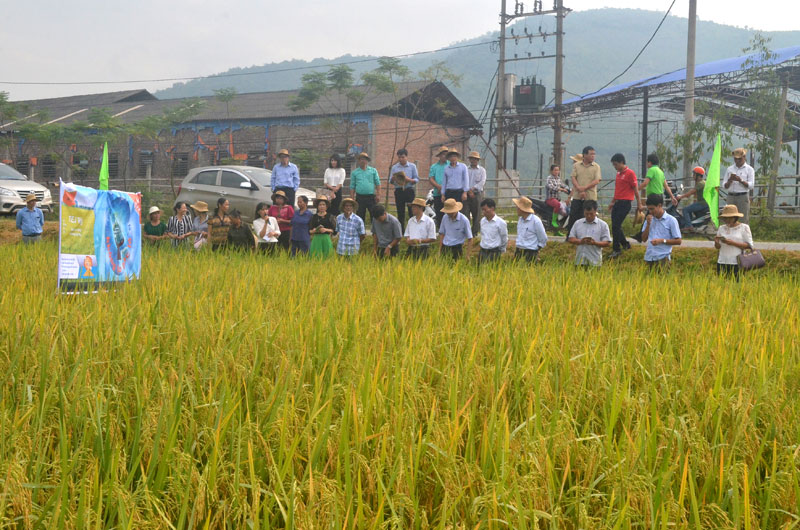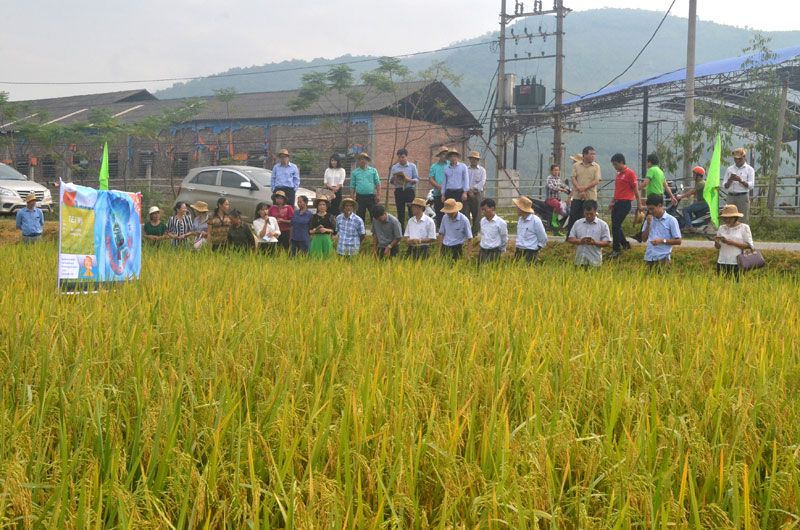
(HBO) – The Department of Agriculture and Rural Development of Hoa Binh province has recently partnered with the national centre for plant varieties and Thai Binh Seed Corporation to hold a conference on directing use of varieties and management of new pests in rice and citrus fruits in the province.

Delegates of the conference visited
the field demonstrations of some new rice varieties in Khang Dinh village, Yen
Mong commune, Hoa Binh city.
The conference reviewed the current use of rice and citrus
seeds in the province. The province has seen the increasing use of high-quality
conventional and hybrid rice but the percentage of use widely varies between
districts.
High-quality conventional rice has been cultivated across
81-90 percent of rice fields in Cao
Phong, Ky Son and Yen
Thuy districts and Hoa Binh city while hybrid rice accounted for a majority of
the rice areas in Lac Thuy district. The hybrid rice is regarded as suitable to
the province’s diversity in terrain, climate and soil.
There is also a growing trend of cultivating high-yield,
high-quality, and short-growth-duration varieties, making it easier for local
farmers in intensive farming, increasing productivity and land use.
Hoa Binh has developed a wide range of citrus varieties in
order to suit the local farmers’ needs to grow the fruits throughout the year
and reduce price drops due to abundant supplies. Most of the citrus varieties
had been piloted in small farms before grown in large areas, so they developed
well in local soil condition and weather.
According to data from the Hoa Binh Provincial Party Committee, the industrial production index for the first six months of 2025 is estimated to have increased by 20% compared to the same period last year. This marks the highest year-on-year growth rate for this period since 2020.
In the first six months of 2025, Hoa Binh province’s export turnover was estimated at 1.145 billion USD, marking an 18.11% increase compared to the same period in 2024. Import turnover was estimated at $ 804 million, a 17.15% increase, which helped the province maintain a positive trade balance.
The lives of the ethnic minority farmers in Tan Lac district have gradually improved thanks to the new directions in agricultural production. This is a testament to the collective strength fostered through the professional associations and groups implemented by various levels of the district’s Farmers’ Union.
With the motto the "product quality comes first,” after nearly one year of establishment and operation, Muong village’s Clean Food Agricultural and Commercial Cooperative, located in Cau Hamlet, Hung Son Commune (Kim Boi district), has launched reputable, high-quality agricultural products to the market that are well-received by consumers. The products such as Muong village’s pork sausage, salt-cured chicken, and salt-cured pork hocks have gradually carved out a place in the market and they are on the path to obtaining the OCOP certification.
In the past, the phrase "bumper harvest, rock-bottom prices" was a familiar refrain for Vietnamese farmers engaged in fragmented, small-scale agriculture. But today, a new spirit is emerging across rural areas of Hoa Binh province - one of collaboration, organisation, and collective economic models that provide a stable foundation for production.
Maintaining growing area codes and packing facility codes in accordance with regulations is a mandatory requirement for agricultural products to be eligible for export. Recently, the Department of Agriculture and Environment of Hoa Binh province has intensified technical supervision of designated farming areas and packing facilities to safeguard the "green passport" that enables its products to access international markets.



